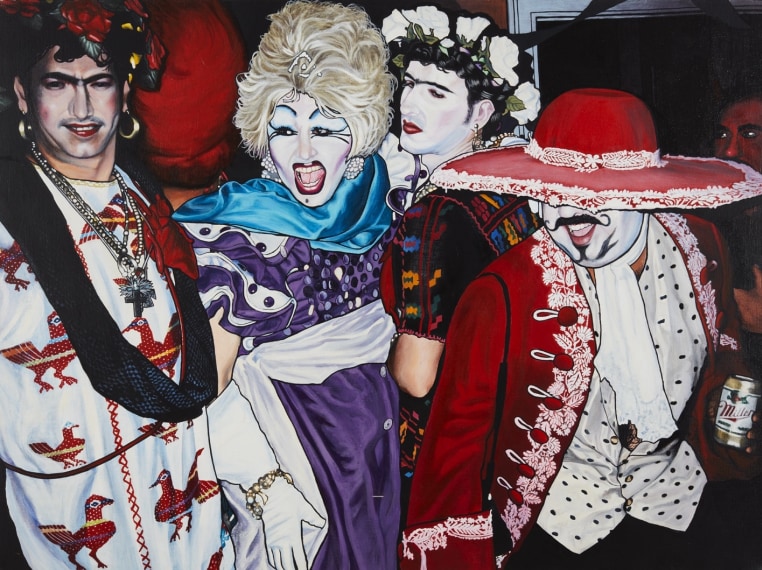
For Frieze Los Angeles 2024, Ortuzar Projects is pleased to present a selection of paintings and works on paper by Carlos Almaraz, Joey Terrill, and Roberto Gil de Montes, all of whom played an integral role in the queer Chicano arts scene during the 1970s and 80s. Bound together by their lived dialogue and the shared landscapes of Los Angeles, these artists discovered friends, mentors, and admirers in one another at a time when there was limited support outside of their own creative networks.
Gil de Montes first crossed paths with the already established Almaraz at Otis Art Institute in the early 1970s. Comparisons quickly arose between the two painters, who were primarily working in figurative styles during a moment dominated by the rise of minimalist and conceptual art. This led to a close friendship and mentorship of the younger artist that continued throughout their lives, persisting until Almaraz’s untimely death from AIDS-related complications in 1989. By the time of their meeting, Almaraz had already become a central figure in the Chicano Power movement, lending his support to Cesar Chavez’s United Farm Workers union through large-scale murals and exhibiting as a part of the collective Los Four at LACMA, the first institutional exhibition of Chicano art. Following his marriage to artist Elsa Flores in 1981, Almaraz shifted away from his earlier focus on muralism and public activism towards a more personal studio practice, resulting in his most recognized works, such as his “Car Crash” series. Staging multi-vehicle collisions against the backdrop of a sun-drenched Los Angeles, the macabre series takes inspiration from his own experience of having his car side swept and totaled outside his Echo Park apartment, as well as his personal struggles with addiction and volatile mental health, epitomizing Almaraz’s ability to crystallize autobiography into instantly recognizable symbols.
Gil de Montes similarly cultivates a personal language to confront themes of queer desire, sensuality, and loss. Born in Guadalajara, Gil de Montes later lived in different cities across the United States, regularly drawing inspiration from a range of cultural references both Western and Non-Western. In Untitled (1989), the artist stages a meeting between two figures in which one is seemingly offered the choice of many masks. While they resemble traditional Huichol and Tecuán masks, the motif also echoes the queer necessity to shape-shift or present oneself differently depending on the nature of a given encounter. In Gil de Montes’ Untitled (1991) the artist depicts a gender-ambiguous figure resembling a winged angel or fairy floating in front of a theatrical curtain. Adorned with wings covered in a patchwork of eyes, the figure breaks the fourth wall as it gazes back outward towards potential spectators with unblinking intensity.
Fourteen years junior to Almaraz and five to Gil de Montes, Terrill was aware of the older artists’ work through activist circles, as they were among the few artists from his community to achieve commercial success. By 1980 the three artists’ paths had converged and as the AIDS crisis unfolded throughout the rest of the decade, Terrill began to utilize his practice to document himself and his loved ones in diaristic works that mimicked the style of a camp-infused fotonovela or comic strip. The Atrium at Crocker Center (1984–85) belongs to the artist’s “Public Art” series, in which he investigates public places across the city of Los Angeles that are adorned with public art through nine-panel paintings. Despite feeling that his “social, economic, and ethnic” positionality precludes him from “relating to or engaging with the big money interests that generate” such spaces, Terrill depicts himself at the center of the compositions, upending expectations of social belonging within these highly corporatized displays of wealth.
As all three artists were navigating their queerness during the early years of the epidemic while grappling with marginalization from multiple fronts, their responses to this tumultuous history presented in diverse yet overlapping ways. Almaraz cast his personal history as allegory, grappling with his subconscious sense of freedom and responsibility as a public figure, while Gil de Montes similarly conjured feelings lingering under the surface of his experiences. Terrill depicted his private life and self-image with explicit realism, attempting to tenderly document his social world–queer and Chicano–in clear-eyed terms.
